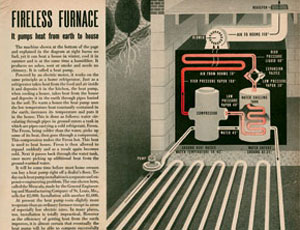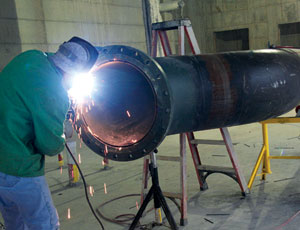An article titled the “Fireless Furnace” appeared in the Oct. 25, 1948, issue of LIFE magazine. There, postwar America witnessed the emergence of a futuristic technology that Lord Kelvin, the king of cold, only dreamed about a century earlier. The fireless furnace avoided burning fossil fuels by piping water through coils in the ground and then through a heat pump. But the technology was too expensive—about $3,000 installed—and too new to gain acceptance. “However, as the efficiency of getting heat from the earth improves, it is almost certain that eventually the heat pump will be able to compete successfully with conventional heaters in most localities,” said the story.

Sixty years later, geothermal-heat pumps (GHPs) and related systems are competing. If designed to be efficient, these systems can produce more energy than they consume—three to five times as much on average—yielding a positive coefficient of performance (COP). But a system’s ability to save the owner money still remains a huge question, considering manufacturers’ equipment labels do not always match real-life performance due to loose regulations; engineers are still struggling with design complexities; contractors are demanding a wide range of drilling, trenching and fit-up fees; the varying geology and climate across the U.S.; and fluctuating energy prices.
“With renewable and alternative energy, you have to think outside the box,” says Jim Bererton, who heads Edmonton, Alberta-based Stantec Consulting’s sustainability practice. “If you try to do [projects] conventionally, you will fail.”
Bererton’s recent experience with geothermal heating, ventilating and air conditioning (HVAC) led him to try some unusual approaches, such as using foundation piles as heat sinks, a fairly common approach in Europe but virtually nonexistent in North America. He also used a special off-road tractor that simultaneously can cut a trench and lay piping. Both methods saved building owners thousands of dollars in installation costs, shortening the payback time by years. Bererton and others say getting the most out of alternative energy forces owners, designers and contractors to break down jobsite barriers and become creative.
As more professionals gain experience with geothermal heat exchange, the technology is maturing. “It has got its driver’s license, but at night, we are still worried about it coming home,” explains Paul Ormond, who heads up the geothermal practice at Manchester, N.H.-based consultant Haley & Aldrich.
Geothermal systems also are becoming larger in size, pushing designers’ old rules of thumb into obsolescence. “Geothermal grew up 30 years ago, making small systems for residential homes,” says Ormond. Now, the technology “is growing up to big buildings…and that is where we see problems in the industry.” Shortcuts, such as sizing a heat pump without conducting an energy audit or considering other factors, may work for homes but do not work on larger buildings, which are more complicated structures. “Engineers do not design residential, three-ton heat-pump systems,” says Warren Lloyd, vice president of Rock Island, Ill.-based KJWW Engineering Consultants. “Contractors do.”
Despite those who feel hot, cold or lukewarm about geothermal, the market for ground-source heat pumps (GSHPs) is on the rise, lately growing at double-digit rates due to high energy prices, green design and pressure on the building sector to cut its carbon emissions. In 2007, shipments of GSHPs surged 36% to 86,396 units, while capacity grew 19% to 291,300 tons of air-handling over the prior year, according to the Energy Information Administration. Ground- and water-source heat pumps (WSHPs) are expected to be a prime strategy in future green building and decarbonization.
The U.S. Dept. of Energy estimates “aggressive deployment” of GHPs could save up to $38 billion annually in...



















Post a comment to this article
Report Abusive Comment